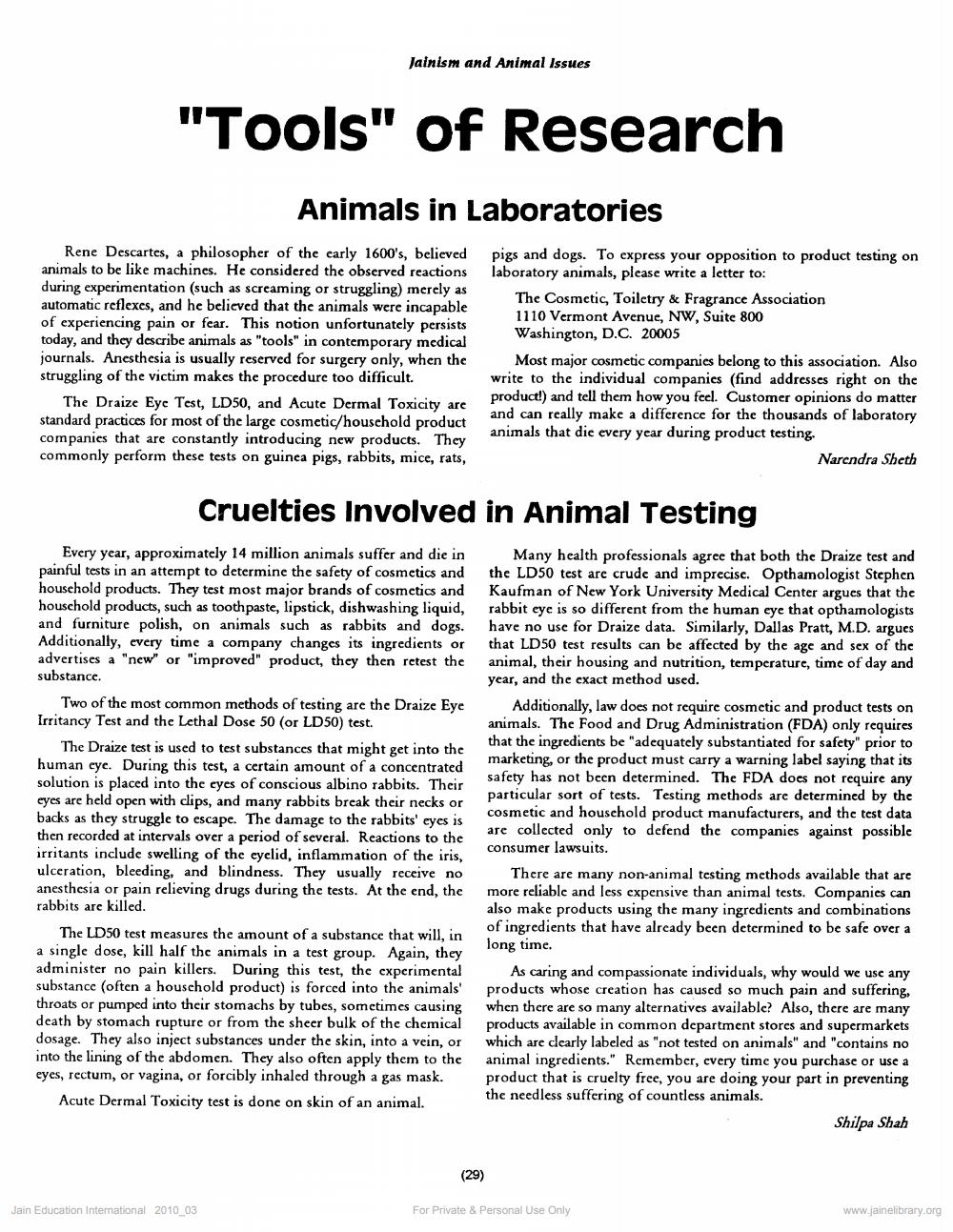________________
Jainism and Animal Issues
"Tools" of Research
Animals in Laboratories
Rene Descartes, a philosopher of the early 1600's, believed animals to be like machines. He considered the observed reactions during experimentation (such as screaming or struggling) merely as automatic reflexes, and he believed that the animals were incapable of experiencing pain or fear. This notion unfortunately persists today, and they describe animals as "tools" in contemporary medical journals. Anesthesia is usually reserved for surgery only, when the struggling of the victim makes the procedure too difficult.
The Draize Eye Test, LD50, and Acute Dermal Toxicity are standard practices for most of the large cosmetic/household product companies that are constantly introducing new products. They commonly perform these tests on guinea pigs, rabbits, mice, rats,
pigs and dogs. To express your opposition to product testing on laboratory animals, please write a letter to:
The Cosmetic, Toiletry & Fragrance Association 1110 Vermont Avenue, NW, Suite 800 Washington, D.C. 20005
Most major cosmetic companies belong to this association. Also write to the individual companies (find addresses right on the product!) and tell them how you feel. Customer opinions do matter and can really make a difference for the thousands of laboratory animals that die every year during product testing,
Narendra Sheth
Cruelties Involved in Animal Testing
Every year, approximately 14 million animals suffer and die in painful tests in an attempt to determine the safety of cosmetics and household products. They test most major brands of cosmetics and household products, such as toothpaste, lipstick, dishwashing liquid, and furniture polish, on animals such as rabbits and dogs. Additionally, every time a company changes its ingredients or advertises a "new" or "improved" product, they then retest the substance.
Two of the most common methods of testing are the Draize Eye Irritancy Test and the Lethal Dose 50 (or LD50) test.
The Draize test is used to test substances that might get into the human cyc. During this test, a certain amount of a concentrated solution is placed into the cyes of conscious albino rabbits. Their eyes are held open with clips, and many rabbits break their necks or backs as they struggle to escape. The damage to the rabbits' eyes is then recorded at intervals over a period of several. Reactions to the irritants include swelling of the eyelid, inflammation of the iris, ulceration, bleeding, and blindness. They usually receive no anesthesia or pain relieving drugs during the tests. At the end, the rabbits are killed.
The LD50 test measures the amount of a substance that will, in a single dose, kill half the animals in a test group. Again, they administer no pain killers. During this test, the experimental substance (often a houschold product) is forced into the animals' throats or pumped into their stomachs by tubes, sometimes causing death by stomach rupture or from the sheer bulk of the chemical dosage. They also inject substances under the skin, into a vein, or into the lining of the abdomen. They also often apply them to the eyes, rectum, or vagina, or forcibly inhaled through a gas mask.
Acute Dermal Toxicity test is done on skin of an animal.
Many health professionals agree that both the Draize test and the LD50 test are crude and imprecise. Opthamologist Stephen Kaufman of New York University Medical Center argues that the rabbit eye is so different from the human eye that opthamologists have no use for Draize data. Similarly, Dallas Pratt, M.D. argues that LD50 test results can be affected by the age and sex of the animal, their housing and nutrition, temperature, time of day and year, and the exact method used.
Additionally, law does not require cosmetic and product tests on animals. The Food and Drug Administration (FDA) only requires that the ingredients be "adequately substantiated for safety" prior to marketing, or the product must carry a warning label saying that its safety has not been determined. The FDA does not require any particular sort of tests. Testing methods are determined by the cosmetic and household product manufacturers, and the test data are collected only to defend the companies against possible consumer lawsuits.
There are many non-animal testing methods available that are more reliable and less expensive than animal tests. Companies can also make products using the many ingredients and combinations of ingredients that have already been determined to be safe over a long time.
As caring and compassionate individuals, why would we use any products whose creation has caused so much pain and suffering, when there are so many alternatives available? Also, there are many products available in common department stores and supermarkets which are dearly labeled as "not tested on animals" and "contains no animal ingredients." Remember, every time you purchase or use a product that is cruelty free, you are doing your part in preventing the needless suffering of countless animals.
Shilpa Shah
(29)
Jain Education Interational 2010_03
For Private & Personal Use Only
www.jainelibrary.org




